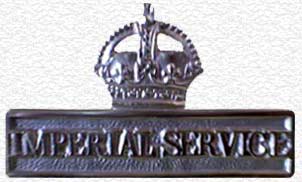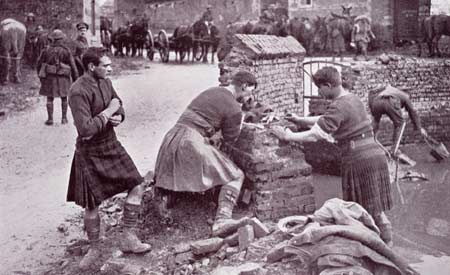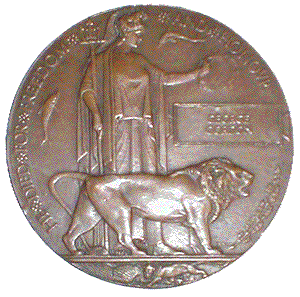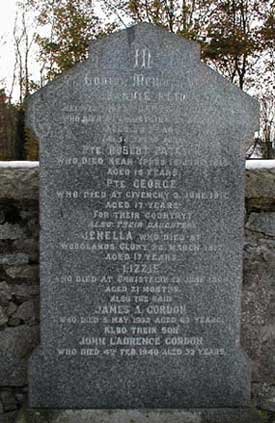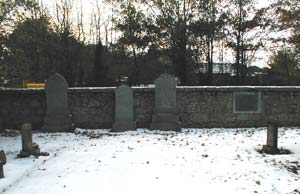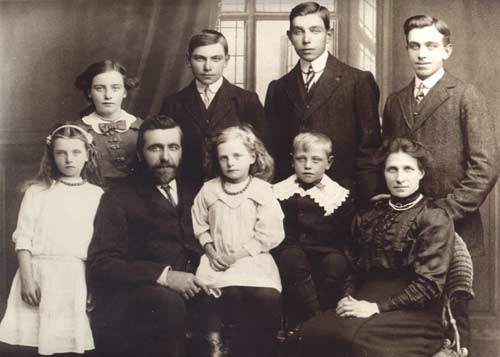|
George Gordon
was born on 25th September 1897 at Christkirk, Kennethmont and was
the third oldest of a family of three brothers and four sisters. His
parents were James Adam and Jeannie Gordon. He was known to his family
and friends as Dod. His father was tenant in the farm of Christkirk
on the Leith Hall Estate which had been farmed by members of the Gordon
family for many years. Dod worked as a farm servant at Leith Hall
Home Farm and was one of three workers there who went off to fight
in the Great War. The others were James Daun
and William Anderson. All of them died
in the conflict. On joining the Territorials a soldier agreed to be available for home service only and could not be posted overseas unless he volunteered to do so, and even then could only serve in his own unit. When the threat of war came in 1914 most of the Territorial Soldiers of The Gordon Highlanders agreed to serve overseas and thus became available for 'Imperial Service'. These men, including Dod Gordon, were then entitled to wear The Imperial Service Badge.
As a member
of 'H' Company, 6th Battalion ( Donside and Banffshire), Gordon Highlanders
(Territorial Force) George reported to The Drill Hall in Huntly with
his Insch comrades when the Battalion were mobilised in the evening
of 4th August 1914. His company marched by road to Keith where all
the companies of the 6th Gordons assembled during 6th-7th August,
the men being billeted in the school and in private houses. Organisation
completed they left Keith by train on 11th August for Perth. On the
16th they moved on to join The Highland Territorial Brigade in The
Highland Division at Bedford and were billeted in private houses in
the Bromham Road area of the town with their Headquarters in the Girls
High School. For three months they trained and prepared for their
eventual move to the Western Front and on 22nd October were reviewed
by the King. On 9th Nov 1914 the Battalion journeyed to Southampton
by train. That evening at the docks they joined the troopship "Cornishman".
They disembarked at Le Havre, France next morning and marched to No1
Reserve Camp on top of the hill behind the town. On the 13th
began the journey up the line ending at St Omer where the General
Headquarters of the British Army in France was located. For three
weeks they received further training for the trenches while billeted
in nearby Blendecques.
Members of 6 GH cleaning up after a tour in the trenches, the man shaving still wears the drab apron over his kilt. This was worn to camouflage the kilt and to help keep it clean and dry in the muddy trenches.
On Christmas
Day 1914 they witnessed a remarkable event amid the death and destruction
- the unofficial Christmas Truce. The truce eventually extended to
3rd January 1915, when normal hostilities resumed. This special
Order was published by Major-General Capper - Dod was wounded, probably at Neuve Chapelle, and spent some time in hospital and later rested for two weeks at No 2 Territorial Base in Rouen before returning to the Battalion at the the front at the end of April having been moved to 'A' Coy's No 3 Platoon. Although not involved in an action at this time it is known that the battalion were in front line trenches at "Windy Corner" in the Festubert - Givenchy sector near Cuinchy. The CWGC record
gives Dod's death as 4th June 1915. In a letter to his father Lt D
McKenzie, commanding "A" Coy, states
that he knew George well as he was his observer. He also states clearly
that he was killed during the afternoon of June 3. Having 'No
Known Grave' George Gordon's name is recorded on the Memorial
to the Missing at Le Touret Cemetery.
The Memorial Plaque This circular
bronze plaque, 4.75 inches (120mm) in diameter, was first issued in
1919 to the next of kin of those British and Commonwealth servicemen
and women who lost their lives on active service during the Great
War. Each one was different in that the commemorated individuals name
was embossed in raised letters within a tablet. The design
shows Britannia bestowing a laurel wreath on the rectangular tablet.
A lion stands in the foreground, with dolphins above and an oak branch
in the lower right. A lion cub clutching a fallen eagle in its jaws
decorates the exergue. The wording around the circumference states:
The final
total manufactured is estimated to be in the vicinity of 1,150,000
units, and represented the most universally distributed numismatic
work ever cast or struck, excluding money. Due to some
similarity with the old one pence coin it was commonly known as a
Dead Man's or Death Penny.
This sad memorial
card bears the photographs and details of the deaths in action of
dod and his older brother Pat.
The Gordon Family, Christkirk. c 1911 Jenella, George,
Robert, James, |

